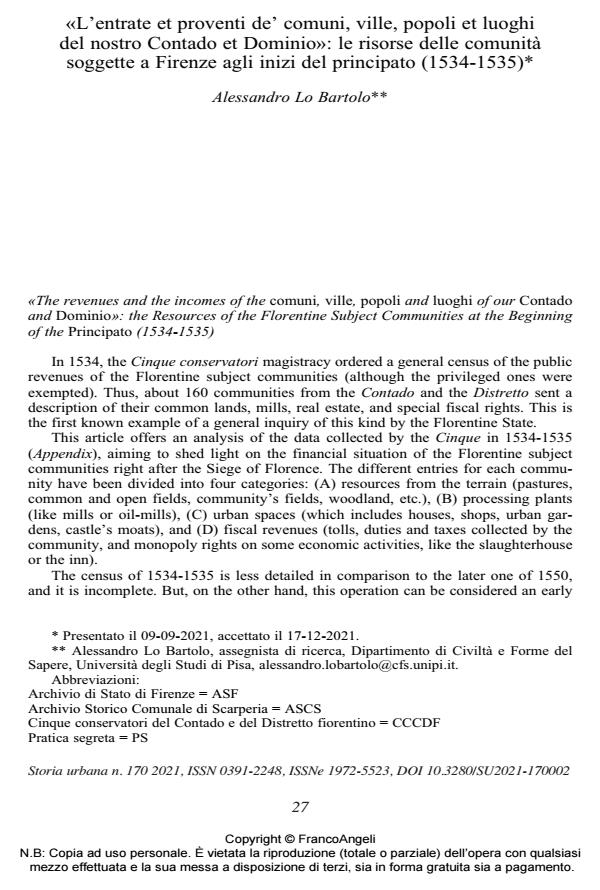«The revenues and the incomes of the comuni, ville, popoli and luoghi of our Contado and Dominio»: the Resources of the Florentine Subject Communities at the Beginning of the Principato (1534-1535)
Journal title STORIA URBANA
Author/s Alessandro Lo Bartolo
Publishing Year 2021 Issue 2021/170
Language Italian Pages 27 P. 27-53 File size 416 KB
DOI 10.3280/SU2021-170002
DOI is like a bar code for intellectual property: to have more infomation
click here
Below, you can see the article first page
If you want to buy this article in PDF format, you can do it, following the instructions to buy download credits

FrancoAngeli is member of Publishers International Linking Association, Inc (PILA), a not-for-profit association which run the CrossRef service enabling links to and from online scholarly content.
In 1534, the Cinque conservatori magistracy ordered a general census of the public revenues of the Florentine subject communities (although the privileged ones were exempted). Thus, about 160 communities from the Contado and the Distretto sent a description of their common lands, mills, real estate, and special fiscal rights. This is the first known example of a general inquiry of this kind by the Florentine State. This article offers an analysis of the data collected by the Cinque in 1534-1535 (Appendix), aiming to shed light on the financial situation of the Florentine subject communities right after the Siege of Florence. The different entries for each community have been divided into four categories: (A) resources from the terrain (pastures, common and open fields, community’s fields, woodland, etc.), (B) processing plants (like mills or oil-mills), (C) urban spaces (which includes houses, shops, urban gardens, castle’s moats), and (D) fiscal revenues (tolls, duties and taxes collected by the community, and monopoly rights on some economic activities, like the slaughterhouse or the inn). The census of 1534-1535 is less detailed in comparison to the later one of 1550, and it is incomplete. But, on the other hand, this operation can be considered an early step towards the administrative tutorship which would be realized under Cosimo I and his successors, aiming to preserve (and eventually to increase) the fiscal potential of the subject communities.
Nel 1534, i Cinque Conservatori avviarono un censimento generale delle entrate delle comunità soggette a Firenze (escludendo però quelle aree tradizionalmente im-muni alla giurisdizione del magistrato). I rappresentanti di circa 160 «luoghi», tra Con- tado e Distretto, eseguirono l’ordine, descrivendo in una «portata» gli introiti derivanti dalle proprietà comunitative: risorse del territorio, impianti industriali, spazi urbani e diritti fiscali. Allo stato attuale delle nostre conoscenze, si tratta della prima indagine di questo tipo effettuata nello Stato fiorentino. L’articolo presenta i dati forniti dal censimento del 1534-1535 (in Appendice), la loro analisi e un primo confronto con quelli del già noto censimento del 1550, con l’o- biettivo di indagare la situazione finanziaria e patrimoniale delle comunità soggette po- chi anni dopo l’assedio di Firenze. Le voci di entrata sono state suddivise in quattro ca- tegorie: risorse del territorio (A), impianti industriali di trasformazione (B), spazi urba- ni (C) e proventi fiscali (D). Il censimento del 1534-1535 è certamente meno dettagliato, e in una certa misura incompleto, rispetto a quello del 1550. Tuttavia, l’operazione, finora non valorizzata dalla storiografia, può essere considerata un passo deciso, ancorché precoce, in dire- zione della "tutela" amministrativa che sarebbe stata dispiegata al tempo di Cosimo I e dei suoi successori, mirante a salvaguardare (e incrementare) la capacità di contribuzione fiscale delle comunità soggette.
Keywords: Medicean Principality, Alessandro de’ Medici, Territorial State, Subject Communities, Commons, Taxation
Alessandro Lo Bartolo, «L’entrate et proventi de’ comuni, ville, popoli et luoghi del nostro Contado et Dominio»: le risorse delle comunità soggette a Firenze agli inizi del principato (1534-1535) in "STORIA URBANA " 170/2021, pp 27-53, DOI: 10.3280/SU2021-170002